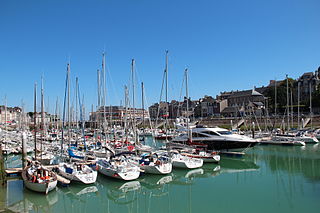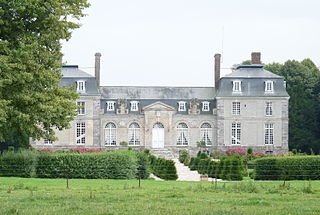
Seine-Maritime is a department of France in the Normandy region of northern France. It is situated on the northern coast of France, at the mouth of the Seine, and includes the cities of Rouen and Le Havre. Until 1955 it was named Seine-Inférieure. It had a population of 1,255,633 in 2019.

Dieppe is a coastal commune in the Seine-Maritime department, Normandy, northern France.

The Pays de Caux is an area in Normandy occupying the greater part of the French département of Seine Maritime in Normandy. It is a chalk plateau to the north of the Seine Estuary and extending to the cliffs on the English Channel coast; its coastline is known as the Côte d'Albâtre. In the east, it borders on the Pays de Bray where the strata below the chalk show through.
Le Tréport is a commune in the Seine-Maritime department in Normandy, France.

The Arrondissement of Rouen is an arrondissement of France in the Seine-Maritime department in the Normandy region. It has 216 communes. Its population is 639,363 (2021), and its area is 1,936.2 km2 (747.6 sq mi).

Saint-Valery-en-Caux is a commune in the Seine-Maritime department in the Normandy region in northern France.
Saint-Martin-en-Campagne is a former commune in the Seine-Maritime department in the Normandy region in northern France. On 1 January 2016, it was merged into the new commune of Petit-Caux.
Tocqueville-en-Caux is a commune in the Seine-Maritime department in the Normandy region in northern France.
Tocqueville-sur-Eu is a former commune in the Seine-Maritime department in the Normandy region in northern France. On 1 January 2016, it was merged into the new commune of Petit-Caux.
Derchigny is a former commune in the Seine-Maritime department in the Normandy region in north-western France. On 1 January 2016, it was merged into the new commune of Petit-Caux. The local name is Derchigny-Graincourt as the commune resulted from the merger of two former communes, Derchigny and Graincourt, in 1822.

Veules-les-Roses is a commune in the Seine-Maritime department in the Normandy region in northern France. It is a member of Les Plus Beaux Villages de France Association.

Hautot-sur-Mer is a commune in the Seine-Maritime department in the Normandy region in northern France.

Varengeville-sur-Mer is a commune in the Seine-Maritime department in the Normandy region in north-western France.

Sainte-Marguerite-sur-Mer is a commune in the Seine-Maritime department in the Normandy region in northern France.

Veulettes-sur-Mer is a commune in the Seine-Maritime department in the Normandy region in northern France.

Sotteville-sur-Mer is a commune in the Seine-Maritime department in the Normandy region in north-western France.

Saint-Sylvain is a commune in the Seine-Maritime department in the Normandy region in northern France.
Torcy-le-Petit is a commune in the Seine-Maritime department in the Normandy region in north-western France.
The former Communauté de communes du Petit Caux was located in the Seine-Maritime département of the Normandy region of north-western France. It was created in January 2002. It was disbanded on 1 January 2016 when its member communes merged into the new commune Petit-Caux.

Petit-Caux is a commune in the department of Seine-Maritime, northern France. The municipality was established on 1 January 2016 by merger of the 18 former communes of Saint-Martin-en-Campagne, Assigny, Auquemesnil, Belleville-sur-Mer, Berneval-le-Grand, Biville-sur-Mer, Bracquemont, Brunville, Derchigny, Glicourt, Gouchaupre, Greny, Guilmécourt, Intraville, Penly, Saint-Quentin-au-Bosc, Tocqueville-sur-Eu and Tourville-la-Chapelle. These communes previously cooperated in the Communauté de communes du Petit Caux.



















